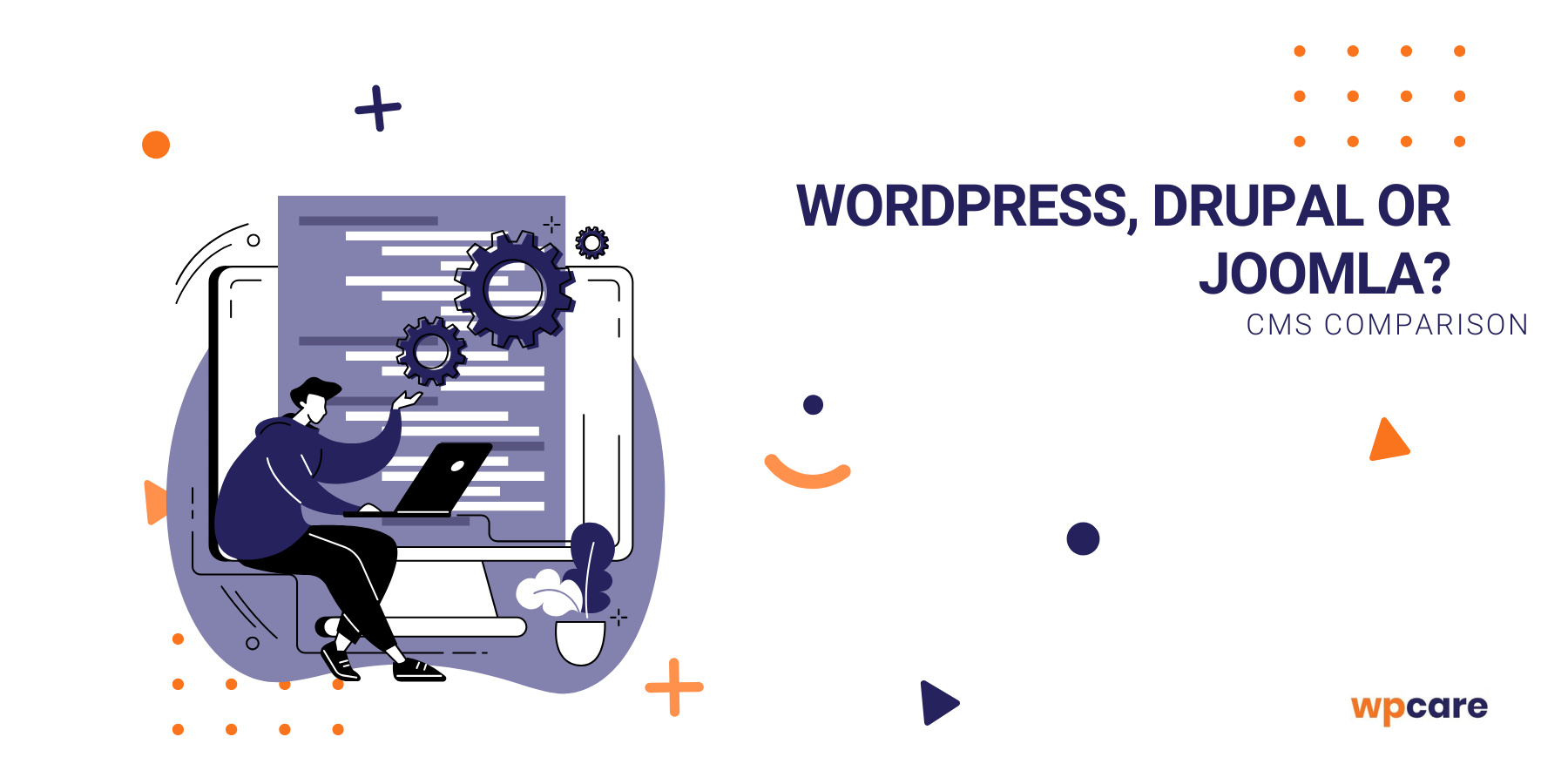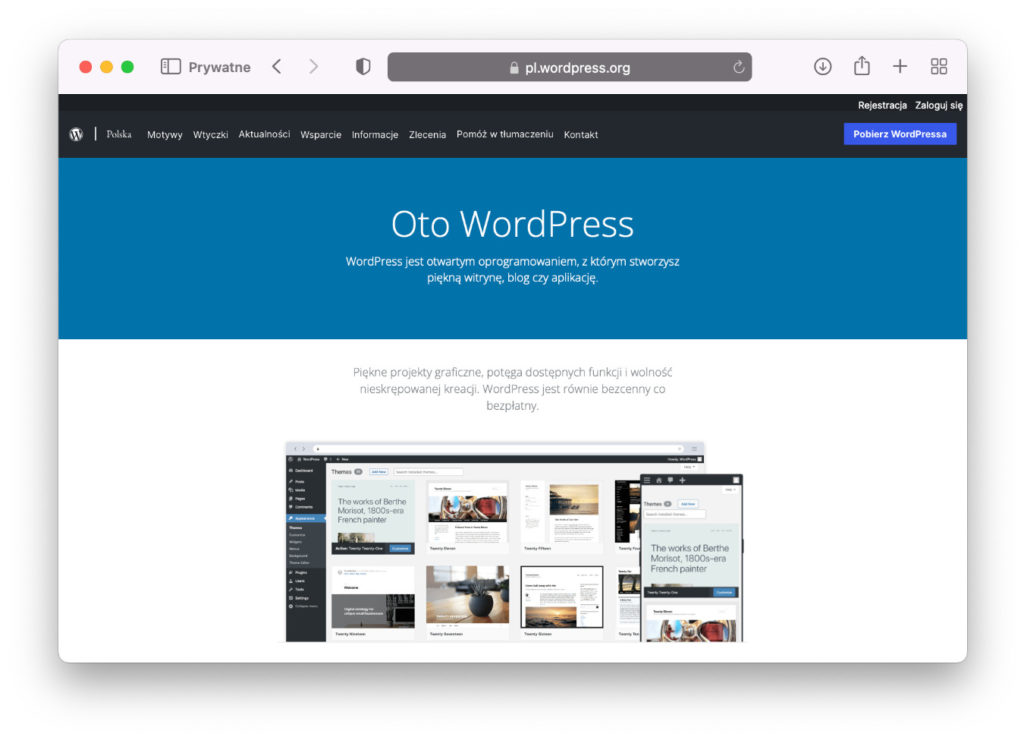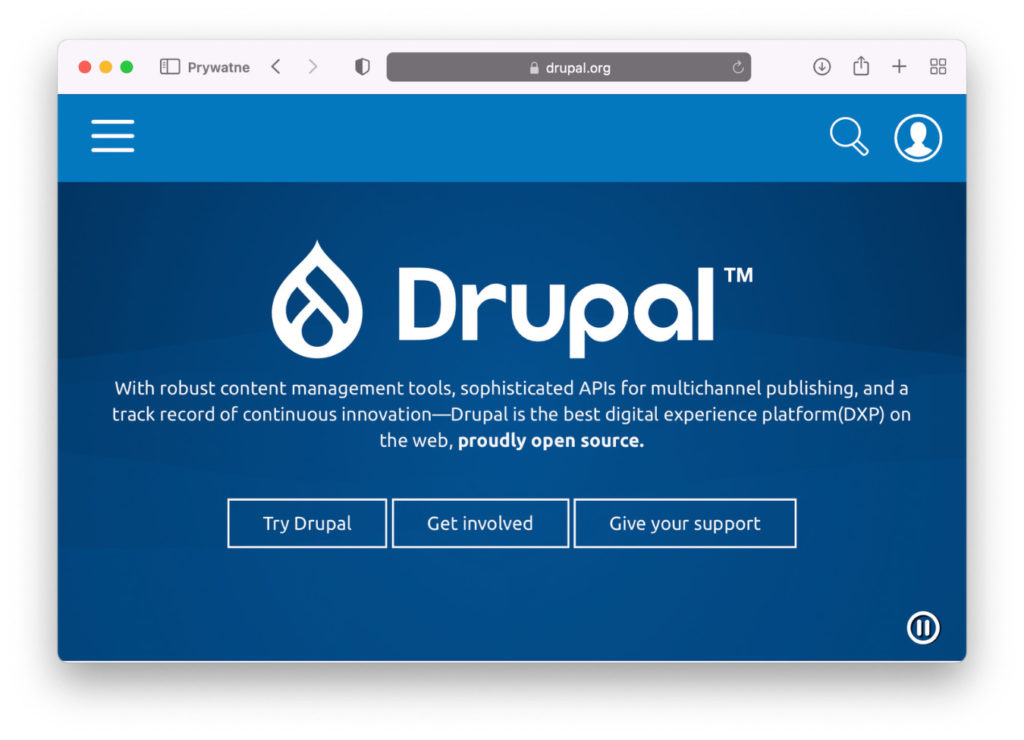There was a time when creating a website or making changes to it without coding knowledge seemed impossible… Especially if it was more than just a simple HTML document. But then, a revolution happened—CMS platforms emerged, completely transforming the way websites are built and managed.
In 2001, Dries Buytaert created Drupal. Two years later, Matt Mullenweg released WordPress, and in 2005, a group of developers introduced Joomla.
These three systems are now the most widely used content management platforms (CMS) in the world. While they share similarities, each has its own unique set of advantages and disadvantages.
Are you wondering which one to use for building your website? In this article, we compare WordPress, Drupal, and Joomla to help you choose the right CMS for your needs.

A few words about CMS systems
What is a CMS?
A Content Management System (CMS) is a tool that allows users to create, edit, and manage website content without requiring advanced technical knowledge. In short, a CMS is a platform that simplifies the publication of online content, such as text, images, videos, and audio files, through an intuitive user interface.
Main CMS functions include:
- Creating, editing, and deleting content: CMS allows users to add new articles, pages, images, videos, and other content to a website. It also enables content editing and removal.
- User management: CMS platforms allow administrators to manage users and assign them appropriate access levels to different sections of the website.
- Version control: Some CMS platforms offer version control features, allowing users to track content changes and restore previous versions. This is particularly useful when multiple people work on a site.
- Appearance customization: Many CMS platforms offer the ability to personalize the website’s appearance by selecting themes.
- SEO optimization: Some systems include tools to optimize content for search engines (SEO), helping to improve the website’s visibility in search results.
What is WordPress?

WordPress is the world’s most popular CMS software, powering approximately 43% of all websites on the internet. It was created in 2003 and initially served as an easy-to-use blogging platform. Over time, it gained more features and quickly became highly popular among both users and developers. Today, WordPress is a versatile platform designed for various types of websites and e-commerce stores, offering numerous themes and plugins.
What is Drupal?

Drupal is the oldest CMS among the three platforms compared. While WordPress was designed with non-technical users in mind, Drupal is more developer-oriented. It is a combination of a typical CMS with framework capabilities. Although it is more challenging to use, it offers greater flexibility for creating advanced websites that handle large amounts of data. Drupal was released in 2001 and has been downloaded approximately 15 million times.
What is Joomla?

Joomla can be considered a compromise between the technically demanding Drupal and the user-friendly WordPress. It is a content management system built on the Model-View-Controller (MVC) design pattern. On one hand, it offers user-friendliness similar to WordPress, while on the other, it provides developer capabilities similar to Drupal.
WordPress vs Drupal vs Joomla – what do they have in common?
Although WordPress, Drupal, and Joomla are separate systems, they are actually very similar. They share many commonalities in terms of technology, philosophy, and community support. What exactly connects them?
- All three systems are open-source software, released under the GNU GPL license, meaning they can be installed, used, and modified completely for free.
- They are primarily written in PHP and use MySQL as a database management system (WordPress exclusively supports MySQL, while Joomla and Drupal also support other database systems).
- All three use themes and templates for website design and rely on plugins, extensions, and modules to add functionalities.
- Each platform has its own dedicated community. Their goal is to ensure continuous development and improvement of the systems by sharing knowledge, supporting users, organizing events, and solving problems.
- They follow almost the same website creation process, which consists of:
- Installing the CMS;
- Choosing a theme;
- Installing plugins/extensions;
- Adding content.
Try it Yourself!
Would you like to test how each CMS looks and works? You can try demo versions of all platforms without having to install any software!
CMS comparison – WordPress vs Drupal vs Joomla
Let’s take a closer look at the different aspects of each system.
-
Popularity and market share
As is well known, WordPress is the most popular CMS in the world. Its market share is around 64%, meaning it is used by over 40% of all websites. Drupal and Joomla do not come close to such numbers… Even though WordPress was created in 2003, its popularity remains high.
Joomla holds only 2.4% of the market share, representing around 1.6% of all websites. The situation is even worse for Drupal, which accounts for only 1.2% of the market. It is also worth noting that WordPress’s market share continues to grow, while Joomla and Drupal are losing users year after year.
-
Ease of use and installation
WordPress
One of the biggest advantages of WordPress is its 5-minute installation process, which can be easily carried out by any beginner. Additionally, most hosting providers offer an auto-installer tool that allows users to install this CMS automatically from the hosting panel. This means that with just one click, you can set up your own website.
Aside from its simple installation, WordPress also features a very clear and intuitive dashboard that does not overwhelm users with too many settings. It is not only easy to navigate but also highly functional. The interface gives users direct access to the official repository with a wide selection of themes and plugins, making it much easier to customize their website.
What truly sets WordPress apart is its content management capabilities. Editing posts and pages, as well as handling multimedia, is highly intuitive. SEO optimization can also be extremely straightforward with the right plugins.
All these features make learning how to use this CMS quick and easy while offering great flexibility.
Joomla
Joomla is not as easy to use as WordPress, but it is still a tool that can be successfully used by non-programmers to build a professional-looking website.
The installation process is very similar to that of WordPress. Since it is one of the top three most popular CMS platforms, some hosting providers also offer a one-click installation feature.After completing the setup, the user lands on the dashboard, which is slightly more complex than WordPress but still appears fairly clear. However, Joomla is often criticized for not being intuitive enough and unnecessarily complicated – for example, it includes many features that users rarely use. Understanding the interface takes some time, but once you get accustomed to using Joomla, working with it should not be too much of a challenge. However, it is worth noting that due to its lower popularity, there are fewer tutorials and guides available online compared to other CMS platforms.
Drupal
Like the previous systems, installing Drupal is not particularly complicated. However, problems may arise after launching the system. It is said that Drupal is more flexible than WordPress or Joomla, but at the same time, it requires a deeper understanding of programming and is significantly harder to master. If you are not technically inclined or have never built a website before, you may struggle to use this CMS efficiently.
This is particularly evident in text formatting options. Drupal assumes that you have at least basic knowledge of HTML and can modify various elements manually. Unlike WordPress, it does not provide an intuitive editing tool for formatting content. Even updating the website requires technical expertise, as you must adjust the code to ensure compatibility with the latest version.
-
Themes and extensions
If you want to extend the core functionality of your CMS, all three platforms offer additional plugins and themes to enhance features and design.
However, they use slightly different terminology:
- WordPress uses plugins (for functionality) and themes (for design).
- Joomla uses extensions (for functionality) and templates (for design).
- Drupal uses modules (for functionality) and themes (for design).
WordPress
WordPress offers over 10,000 free themes and 60,000 free plugins available directly from its admin dashboard repository. Additionally, thousands of premium add-ons can be found on platforms like ThemeForest or from independent WordPress-focused developers.
It is worth noting that WordPress plugins, like the entire system, are designed with user-friendliness in mind. Installation and configuration do not require technical knowledge, and they often come with well-structured interfaces and easy-to-understand control panels. Furthermore, due to the vast number of available plugins, if you need a specific feature for your site, there is a high chance that a plugin already exists for it.

Top 3 must-have WordPress plugins for Your website!
read moreDrupal
The Drupal repository contains over 3,000 themes and nearly 50,000 official modules. Just like WordPress, the Drupal open-source community has created many unofficial add-ons as well. While these numbers seem impressive, if we consider only the extensions compatible with Drupal 8 (the latest version), the count drops significantly to around 4,000 modules and 250 themes.
A significant drawback is that the Drupal catalog is not integrated into the admin panel. This means that most of these extensions must be manually found, installed, and configured, making the process less intuitive compared to WordPress.
Joomla
Among these three CMS platforms, Joomla offers the smallest selection. Its official extension catalog contains nearly 6,000 add-ons, all of which can be accessed from the admin panel.
Unlike WordPress and Drupal, Joomla does not have an official template repository. However, many developers create and distribute their own designs, either for free or as paid options through dedicated websites such as JoomlArt, Joomla-Monster, or Themeforest.
-
Security
WordPress security
According to a report by Sucuri (a company specializing in website security), WordPress is currently the most frequently attacked CMS. Nearly 96% of infected websites in 2021 were based on this platform. However, this should not deter you from using it! There are several reasons behind this statistic.
First, WordPress is the most popular CMS in the world, with a vast number of websites relying on it. This makes it an attractive target for cybercriminals. If they manage to exploit a vulnerability, the potential “gains” are significant, as they can affect many more websites than if they were targeting Drupal or Joomla.
Second, WordPress is extremely user-friendly, attracting many users without technical expertise. Many of them do not implement proper security measures, such as keeping the system and plugins up to date or verifying the security of installed extensions. This makes them easy prey for hackers. However, WordPress is secure when configured correctly and regularly updated.
Third, while WordPress itself is secure, its vast ecosystem of themes and plugins developed by third parties varies in security quality. According to a survey conducted by Wordfence, vulnerabilities in plugins accounted for 56% of all points of entry for malicious attacks.

Why is performing regular WordPress updates important?
Even the best security measures won't work if you forget about regular WordPress updates!read moreDrupal security
Drupal has a much smaller market share than WordPress, which means it is less frequently targeted by hackers. However, this is not the only reason for its security.
Over the years, Drupal has earned a reputation as one of the most secure CMS platforms. This is why it is commonly chosen by government institutions and other organizations that prioritize security. Additionally, since Drupal has fewer third-party themes and extensions, there are fewer potential entry points for attacks compared to WordPress.
The fact that the White House switched from Drupal to WordPress in 2017 should be a strong indicator that it is possible to create a secure website using WordPress just as effectively as with Drupal.
Joomla security
Joomla’s security level is similar to WordPress, but because it is less popular, it is targeted less frequently by hackers. Like the other platforms, vulnerabilities do occur but are generally detected and patched quickly.
Joomla provides easy access to security logs, user permission management tools, and a two-factor authentication system integrated into the core. Like its competitors, the platform regularly receives security patches and bug fixes.
WordPress, Drupal, and Joomla can all be secure if users take appropriate measures, such as keeping their software updated and using strong passwords.
-
Updates
How frequently can you expect updates for these CMS platforms?
For WordPress, updates are released approximately every 2-3 months. These are typically minor updates addressing bugs and security fixes. Major system updates occur several times a year.
Joomla releases minor updates more frequently, roughly every 10-40 days, but major updates are less frequent—sometimes just once a year or even less. For example, Joomla 3.x was released in 2012, while Joomla 4.x only became available in August 2021.
Drupal follows a fixed release schedule, providing one bug fix update and one security update each month. Major versions are released twice a year.
-
Support and community
All three CMS platforms have active open-source communities that support their development and provide technical assistance.
WordPress
WordPress offers a dedicated support section on its official website. There, you can find tutorials, documentation, and user forums where others can help resolve issues. Additionally, WordPress has a vast online community. No matter what problem you encounter, a solution is likely just a Google search away. Many websites and companies specialize entirely in WordPress.
If you need professional assistance, finding WordPress developers is much easier than for Joomla or Drupal. You can also take advantage of WordPress site management packages from WP Care. Their experienced team ensures your website remains functional, secure, and optimized.
Joomla
While Joomla lags behind WordPress in popularity, it still has tens of millions of users forming an active community. As a result, finding tutorials, articles, and video guides is not difficult. The official Joomla website includes extensive documentation with over 9,500 articles written by the Joomla community.
However, hiring a Joomla expert for technical support can be more challenging and expensive compared to WordPress.
Drupal
Drupal also has a passionate and engaged community that actively supports its users. However, since Drupal requires more technical expertise, its community is more specialized than that of WordPress or Joomla. Most Drupal users are developers.
Drupal provides online support through its User Guide and a dedicated support page, featuring forums, documentation, community tools, books, and training resources.



